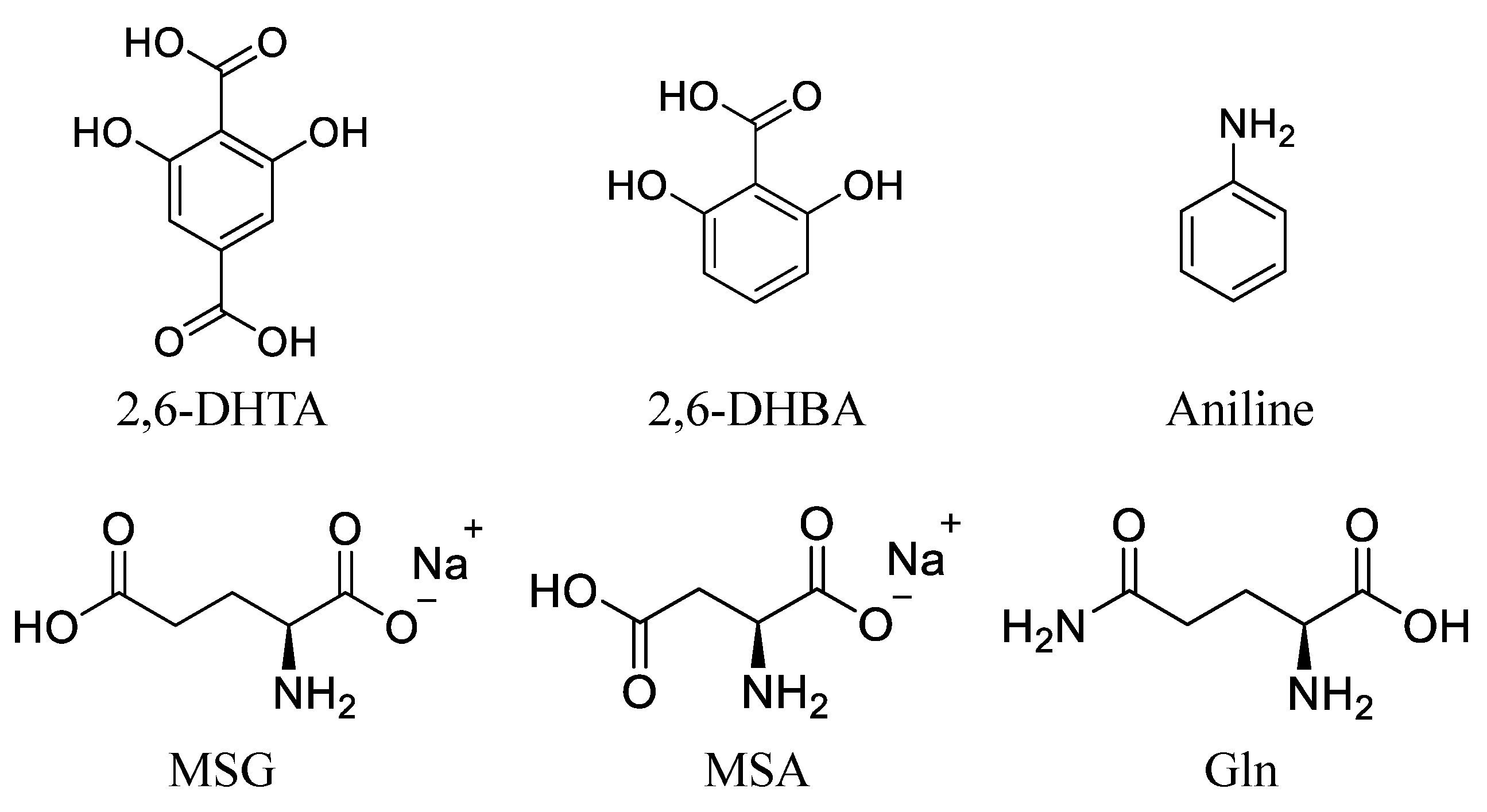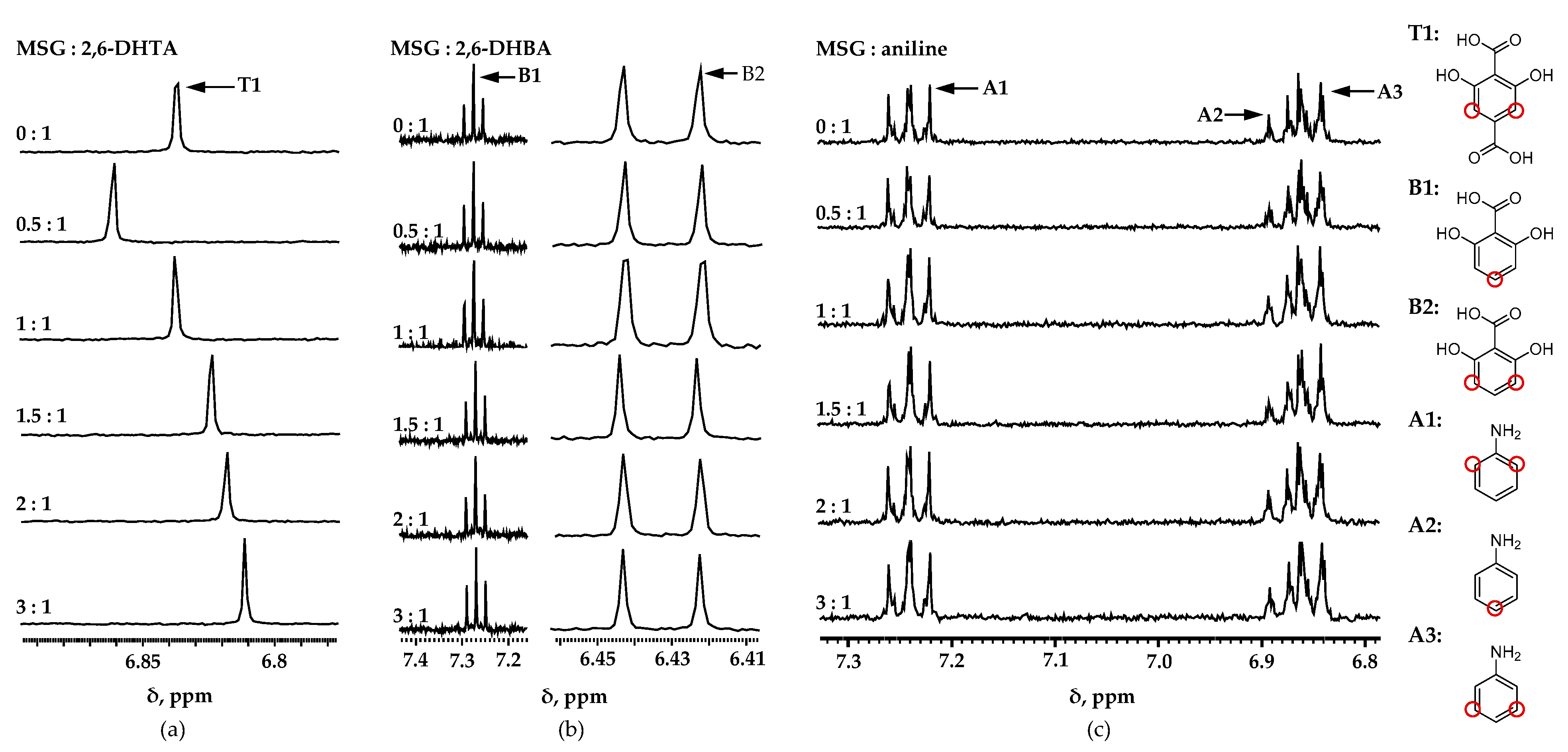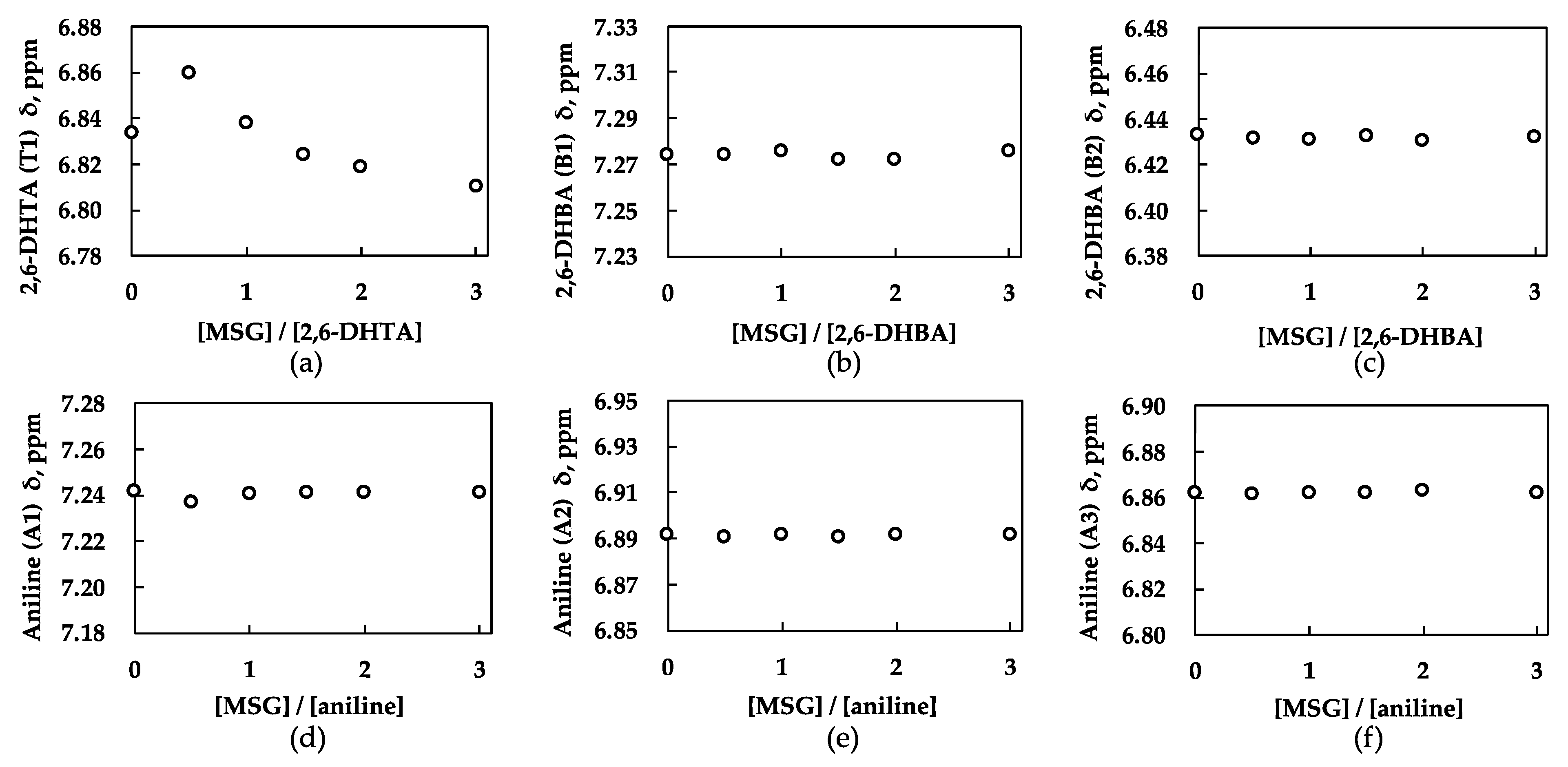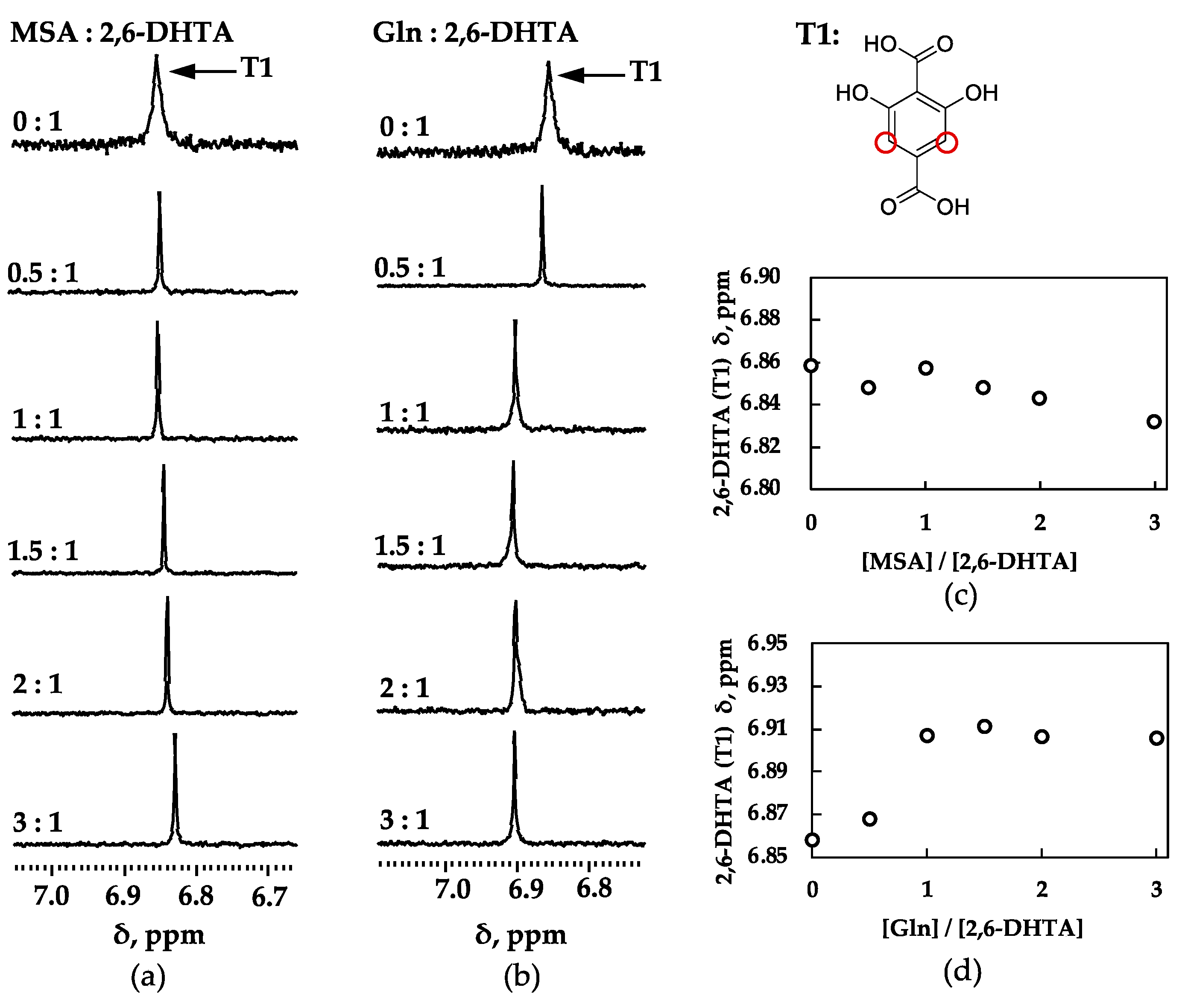Investigating the Mechanism Underlying Umami Substance Detection in Taste Sensors by Using 1H-NMR Analysis
Abstract
:1. Introduction
2. Materials and Methods
2.1. Reagents
2.2. Fabrication of Lipid/Polymer Membrane
2.3. Measurement of Umami Substances by Fabricated Taste Sensors
2.4. Measurement of Umami Substances and Modifiers by 1H-NMR
3. Results and Discussion
3.1. Detection of Umami Substances Using Taste Sensors Treated with 2,6-DHTA, 2,6-DHBA, and Aniline
3.2. Investigation of the Interaction between Modifiers and Umami Substances by 1H-NMR
3.3. Discussion of Experimental Results from Taste Sensors and 1H-NMR Measurements
3.4. Prediction of the Binding Form and Response Mechanism between 2,6-DHTA and MSG
4. Conclusions
Supplementary Materials
Author Contributions
Funding
Institutional Review Board Statement
Informed Consent Statement
Data Availability Statement
Conflicts of Interest
References
- Nakamura, E. One Hundred Years since the Discovery of the “Umami” Taste from Seaweed Broth by Kikunae Ikeda, Who Transcended His Time. Chem. Asian J. 2011, 6, 1659–1663. [Google Scholar] [CrossRef]
- Wang, W.; Zhou, X.; Liu, Y. Characterization and Evaluation of Umami Taste: A Review. TrAC Trends Analyt. Chem. 2020, 127, 115876. [Google Scholar] [CrossRef]
- De Araujo, I.E.T.; Kringelbach, M.L.; Rolls, E.T.; Hobden, P. Representation of Umami Taste in the Human Brain. J. Neurophysiol. 2003, 90, 313–319. [Google Scholar] [CrossRef]
- Diepeveen, J.; Moerdijk-Poortvliet, T.C.W.; van der Leij, F.R. Molecular Insights into Human Taste Perception and Umami Tastants: A Review. J. Food Sci. 2022, 87, 1449–1465. [Google Scholar] [CrossRef]
- Morita, R.; Ohta, M.; Hayabuchi, H.; Fujitani, S.; Yoshida, S.; Matsumoto, H.; Tsuchihashi, T. Quantitative Verification of the Effect of Using an Umami Substance (L-Glutamate) to Reduce Salt Intake. Hypertens. Res. 2020, 43, 579–581. [Google Scholar] [CrossRef]
- Rosa, M.; Pinto-e-Silva, M.E.M.; Simoni, N.K. Can Umami Taste Be an Adequate Tool for Reducing Sodium in Food Preparations? Int. J. Food Sci. Technol. 2021, 56, 5315–5324. [Google Scholar] [CrossRef]
- Uneyama, H.; Kawai, M.; Sekine-Hayakawa, Y.; Torii, K. Contribution of Umami Taste Substances in Human Salivation during Meal. J. Med. Investig. 2009, 56, 197–204. [Google Scholar] [CrossRef]
- Sasano, T.; Satoh-Kuriwada, S.; Shoji, N. The Important Role of Umami Taste in Oral and Overall Health. Flavour 2015, 4, 10. [Google Scholar] [CrossRef]
- Kouzuki, M.; Taniguchi, M.; Suzuki, T.; Nagano, M.; Nakamura, S.; Katsumata, Y.; Matsumoto, H.; Urakami, K. Effect of Monosodium L-Glutamate (Umami Substance) on Cognitive Function in People with Dementia. Eur. J. Clin. Nutr. 2019, 73, 266–275. [Google Scholar] [CrossRef] [PubMed]
- Tomoe, M.; Inoue, Y.; Sanbe, A.; Toyama, K.; Yamamoto, S.; Komatsu, T. Clinical Trial of Glutamate for the Improvement of Nutrition and Health in the Elderly. Ann. N. Y. Acad. Sci. 2009, 1170, 82–86. [Google Scholar] [CrossRef]
- Yatabe, R.; Shunori, A.; Wyszynski, B.; Hanai, Y.; Nakao, A.; Nakatani, M.; Oki, A.; Oka, H.; Washio, T.; Toko, K. Odor Sensor System Using Chemosensitive Resistor Array and Machine Learning. IEEE Sens. J. 2021, 21, 2077–2083. [Google Scholar] [CrossRef]
- Hannon, A.; Lu, Y.; Li, J.; Meyyappan, M. A Sensor Array for the Detection and Discrimination of Methane and Other Environmental Pollutant Gases. Sensors 2016, 16, 1163. [Google Scholar] [CrossRef] [PubMed]
- Kalaw, J.M.; Sevilla, F.B. Discrimination of Wood Species Based on a Carbon Nanotube/Polymer Composite Chemiresistor Array. Holzforschung 2018, 72, 215–223. [Google Scholar] [CrossRef]
- Toko, K. A Taste Sensor. Meas. Sci. Technol. 1998, 9, 1919. [Google Scholar] [CrossRef]
- Wu, X.; Tahara, Y.; Yatabe, R.; Toko, K. Taste Sensor: Electronic Tongue with Lipid Membranes. Anal. Sci. 2020, 36, 147–159. [Google Scholar] [CrossRef]
- Gabrieli, G.; Muszynski, M.; Ruch, P.W. A Reconfigurable Integrated Electronic Tongue and Its Use in Accelerated Analysis of Juices and Wines. In Proceedings of the 2022 IEEE International Symposium on Olfaction and Electronic Nose (ISOEN), Aveiro, Portugal, 29 May–1 June 2022; pp. 1–3. [Google Scholar]
- Kumar, S.; Ghosh, A. An Improved Fractional-Order Circuit Model for Voltammetric Taste Sensor System with Infused Tea as Analyte. IEEE Sens. J. 2020, 20, 7792–7800. [Google Scholar] [CrossRef]
- Wei, X.; Wang, B.; Cao, X.; Zhou, H.; Wu, Z.; Wang, Z.L. Dual-Sensory Fusion Self-Powered Triboelectric Taste-Sensing System towards Effective and Low-Cost Liquid Identification. Nat. Food 2023, 4, 721–732. [Google Scholar] [CrossRef]
- Fan, Y.; Chen, W.; Zhang, N.; Li, M.; Zhu, Y.; Chen, G.; Zhang, Y.; Liu, Y. Umami Taste Evaluation Based on a Novel Mouse Taste Receptor Cell-Based Biosensor. Biosens. Bioelectron. 2023, 237, 5447. [Google Scholar] [CrossRef]
- Liu, J.; Zhang, N.; Li, J.; Li, M.; Wang, G.; Wang, W.; Fan, Y.; Jiang, S.; Chen, G.; Zhang, Y.; et al. A Novel Umami Electrochemical Biosensor Based on AuNPs@ZIF-8/Ti3C2 MXene Immobilized T1R1-VFT. Food Chem. 2022, 397, 133838. [Google Scholar] [CrossRef]
- Chen, W.; Huang, Y.; Jiang, S.; Chen, G.; Liu, Y. Research on Sensing Characteristics of Three Human Umami Receptors via Receptor-Based Biosensor. Flavour Fragr. J. 2020, 35, 695–702. [Google Scholar] [CrossRef]
- Pauliukaite, R.; Zhylyak, G.; Citterio, D.; Spichiger-Keller, U.E. L-Glutamate Biosensor for Estimation of the Taste of Tomato Specimens. Anal. Bioanal. Chem. 2006, 386, 220–227. [Google Scholar] [CrossRef]
- Kong, L.; Dong, Y.; Shu, G.; Feng, Y.; Zhu, M. Multienzyme-Mediated Dual-Channel Magnetic Relaxation Switching Taste Biosensor (D-MRSTB) for Simultaneous Detection of Umami Compounds and Synergistic Enhancement in Food. ACS Sens. 2023, 9, 1820–1830. [Google Scholar] [CrossRef]
- Hwang, Y.H.; Ismail, I.; Joo, S.T. Identification of Umami Taste in Sous-Vide Beef by Chemical Analyses, Equivalent Umami Concentration, and Electronic Tongue System. Foods 2020, 9, 251. [Google Scholar] [CrossRef]
- Hayashi, N.; Chen, R.; Ikezaki, H.; Ujihara, T. Evaluation of the Umami Taste Intensity of Green Tea by a Taste Sensor. J. Agric. Food Chem. 2008, 56, 7384–7387. [Google Scholar] [CrossRef]
- Woertz, K.; Tissen, C.; Kleinebudde, P.; Breitkreutz, J. A Comparative Study on Two Electronic Tongues for Pharmaceutical Formulation Development. J. Pharm. Biomed. Anal. 2011, 55, 272–281. [Google Scholar] [CrossRef]
- Iiyama, S.; Kuga, H.; Ezaki, S.; Hayashi, K.; Toko, K. Peculiar Change in Membrane Potential of Taste Sensor Caused by Umami Substances. Sens. Actuators 55B Chem. 2003, 91, 191–194. [Google Scholar] [CrossRef]
- Yuan, W.; Zhao, Z.; Kimura, S.; Toko, K. Development of Taste Sensor with Lipid/Polymer Membranes for Detection of Umami Substances Using Surface Modification. Biosensors 2024, 14, 95. [Google Scholar] [CrossRef]
- Xu, H.; Zhao, Z.; Kimura, S.; Onodera, T.; Toko, K. Molecular Structure Underlying the Allosteric Mechanism of Caffeine Detection in Taste Sensor. Chemosensors 2023, 11, 97. [Google Scholar] [CrossRef]
- Yoshimatsu, J.; Toko, K.; Tahara, Y.; Ishida, M.; Habara, M.; Ikezaki, H.; Kojima, H.; Ikegami, S.; Yoshida, M.; Uchida, T. Development of Taste Sensor to Detect Non-Charged Bitter Substances. Sensors 2020, 20, 3455. [Google Scholar] [CrossRef] [PubMed]
- Edison, A.S.; Colonna, M.; Gouveia, G.J.; Holderman, N.R.; Judge, M.T.; Shen, X.; Zhang, S. NMR: Unique Strengths That Enhance Modern Metabolomics Research. Anal. Chem. 2021, 93, 478–499. [Google Scholar] [CrossRef]
- De Graaf, R.A. Basic Principles. In In Vivo NMR Spectroscopy: Principles and Techniques; John Wiley & Sons: Chichester, UK, 2019; pp. 1–40. [Google Scholar]
- Günther, H. The Proton Magnetic Resonance Spectra of Organic Molecules-Chemical Shift and Spin-Spin Coupling. In NMR Spectroscopy: Basic Principles, Concepts and Applications in Chemistry; Wiley-VCH: Weinheim, Germany, 2013; pp. 29–66. ISBN 978-3-527-67477-0. [Google Scholar]
- Kawai, M.; Sekine-Hayakawa, Y.; Okiyama, A.; Ninomiya, Y. Gustatory Sensation of L-And D-Amino Acids in Humans. Amino Acids 2012, 43, 2349–2358. [Google Scholar] [CrossRef] [PubMed]
- Zhang, T.; Liu, F.; Chen, W.; Wang, J.; Li, K. Influence of Intramolecular Hydrogen Bond of Templates on Molecular Recognition of Molecularly Imprinted Polymers. Anal. Chim. Acta. 2001, 450, 53–61. [Google Scholar] [CrossRef]
- Dunn, G.E.; Kung, F. Effect of Intramolecular Hydrogen Bonding on Ionization Constants of Substituted Salicylic Acids. Can. J. Chem. 1996, 44, 1261–1269. [Google Scholar] [CrossRef]
- Fiedler, P.; Böhm, S.; Kulhánek, J.; Exner, O. Acidity of Ortho-Substituted Benzoic Acids: An Infrared and Theoretical Study of the Intramolecular Hydrogen Bonds. Org. Biomol. Chem. 2006, 4, 2003–2011. [Google Scholar] [CrossRef] [PubMed]
- Williamson, M.P. Using Chemical Shift Perturbation to Characterise Ligand Binding. Prog. Nucl. Magn. Reson. Spectrosc. 2013, 73, 1–16. [Google Scholar] [CrossRef] [PubMed]
- Govindaraju, V.; Young, K.; Maudsley, A.A. Proton NMR Chemical Shifts and Coupling Constants for Brain Metabolites. NMR Biomed. 2000, 13, 129–153. [Google Scholar] [CrossRef] [PubMed]
- Žagar, E.; Grdadolnik, J. An Infrared Spectroscopic Study of H-Bond Network in Hyperbranched Polyester Polyol. J. Mol. Struct. 2003, 658, 143–152. [Google Scholar] [CrossRef]
- Leiserowitz, L. Molecular Packing Modes. Carboxylic Acids. Acta. Cryst. 1976, 32, 775–802. [Google Scholar] [CrossRef]
- Duggirala, N.K.; Wood, G.P.F.; Fischer, A.; Wojtas, Ł.; Perry, M.L.; Zaworotko, M.J. Hydrogen Bond Hierarchy: Persistent Phenol⋯Chloride Hydrogen Bonds in the Presence of Carboxylic Acid Moieties. Cryst. Growth Des. 2015, 15, 4341–4354. [Google Scholar] [CrossRef]







| Modifier | Taste Sensor Response (100 mM Sample) | Chemical Shift Changes Investigated by 1H-NMR | |
|---|---|---|---|
| Modifier | MSG | ||
| 2,6-DHTA | 96.0 mV | Yes | Yes |
| 2,6-DHBA | −5.0 mV | No | Yes |
| Aniline | 0.7 mV | No | No |
| Analytes | Taste Sensor Response (100 mM Sample) | Chemical Shift Changes Investigated by 1H-NMR | |
|---|---|---|---|
| 2,6-DHTA | Analytes | ||
| MSG | 96.0 mV | Yes | Yes |
| MSA | 80.6 mV | Yes | Yes |
| Gln | 21.0 mV | Yes | No |
Disclaimer/Publisher’s Note: The statements, opinions and data contained in all publications are solely those of the individual author(s) and contributor(s) and not of MDPI and/or the editor(s). MDPI and/or the editor(s) disclaim responsibility for any injury to people or property resulting from any ideas, methods, instructions or products referred to in the content. |
© 2024 by the authors. Licensee MDPI, Basel, Switzerland. This article is an open access article distributed under the terms and conditions of the Creative Commons Attribution (CC BY) license (https://creativecommons.org/licenses/by/4.0/).
Share and Cite
Yuan, W.; Ide, H.; Zhao, Z.; Koshi, M.; Kimura, S.; Matsui, T.; Toko, K. Investigating the Mechanism Underlying Umami Substance Detection in Taste Sensors by Using 1H-NMR Analysis. Chemosensors 2024, 12, 146. https://doi.org/10.3390/chemosensors12080146
Yuan W, Ide H, Zhao Z, Koshi M, Kimura S, Matsui T, Toko K. Investigating the Mechanism Underlying Umami Substance Detection in Taste Sensors by Using 1H-NMR Analysis. Chemosensors. 2024; 12(8):146. https://doi.org/10.3390/chemosensors12080146
Chicago/Turabian StyleYuan, Wenhao, Haruna Ide, Zeyu Zhao, Mariko Koshi, Shunsuke Kimura, Toshiro Matsui, and Kiyoshi Toko. 2024. "Investigating the Mechanism Underlying Umami Substance Detection in Taste Sensors by Using 1H-NMR Analysis" Chemosensors 12, no. 8: 146. https://doi.org/10.3390/chemosensors12080146






